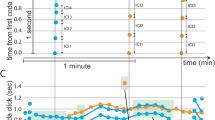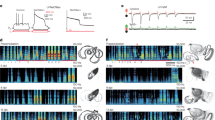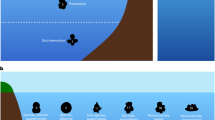These Arctic animals abandon their daily rhythms when it is dark all day or light all night.
Abstract
The light/dark cycle of day and night synchronizes an internal ‘biological clock’ that governs daily rhythms in behaviour, but this form of regulation is denied to polar animals for most of the year. Here we demonstrate that the continuous lighting conditions of summer and of winter at high latitudes cause a loss in daily rhythmic activity in reindeer living far above the Arctic Circle. This seasonal absence of circadian rhythmicity may be a ubiquitous trait among resident polar vertebrates.
This is a preview of subscription content, access via your institution
Access options
Subscribe to this journal
Receive 51 print issues and online access
$199.00 per year
only $3.90 per issue
Buy this article
- Purchase on Springer Link
- Instant access to full article PDF
Prices may be subject to local taxes which are calculated during checkout

Similar content being viewed by others
References
Lowrey, P. L. & Takahashi, J. S. Annu. Rev. Genom. Hum. Genet. 4, 407–441 (2004).
Daan, S & Aschoff, J. in Circadian Clocks (eds Takahashi, J. S. et al.) 7–43 (Plenum, New York, 2001).
de Mairan, J. J. in Histoire de l'Académie Royale des Sciences 35–36 (Paris, 1729).
Gerkema, M. P. in Biological Rhythms (ed. Kumar, V.) 207–215 (Narosa, New Dehli, 2002).
Stokkan, K. A., Mortensen, A. & Blix, A. S. Am. J. Physiol. 251, 264–267 (1986).
Reierth, E., van't Hof, T. & Stokkan, K. A. J. Biol. Rhyth. 14, 314–319 (1999).
Stokkan, K. A., Tyler, N. J. C. & Reiter, R. J. Can. J. Zool. 72, 904–909 (1994).
Hau, M. & Gwinner, E. Physiol. Behav. 58, 89–95 (1995).
Hut, R. A., Van der Zee, E. A., Jansen, K., Gerkema, M. P. & Daan, S. J. Comp. Physiol. B 172, 59–70 (2002).
Author information
Authors and Affiliations
Corresponding author
Ethics declarations
Competing interests
The authors declare no competing financial interests.
Supplementary information
Supplementary Information
(DOC 66 kb)
Rights and permissions
About this article
Cite this article
van Oort, B., Tyler, N., Gerkema, M. et al. Circadian organization in reindeer. Nature 438, 1095–1096 (2005). https://doi.org/10.1038/4381095a
Published:
Issue Date:
DOI: https://doi.org/10.1038/4381095a
This article is cited by
-
Disturbance of suprachiasmatic nucleus function improves cardiac repair after myocardial infarction by IGF2-mediated macrophage transition
Acta Pharmacologica Sinica (2023)
-
The circadian and photoperiodic clock of the pea aphid
Journal of Comparative Physiology A (2023)
-
Behavioral and physiological stress responses of barren-ground caribou (Rangifer tarandus groenlandicus) to industrial ice roads
Polar Biology (2023)
-
The seasons within: a theoretical perspective on photoperiodic entrainment and encoding
Journal of Comparative Physiology A (2023)
-
Disparate roost sites drive intraspecific physiological variation in a Malagasy bat
Oecologia (2022)
Comments
By submitting a comment you agree to abide by our Terms and Community Guidelines. If you find something abusive or that does not comply with our terms or guidelines please flag it as inappropriate.



